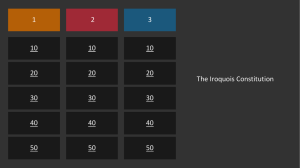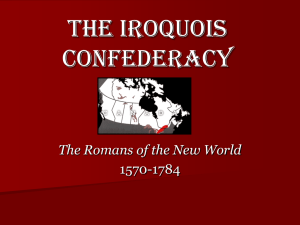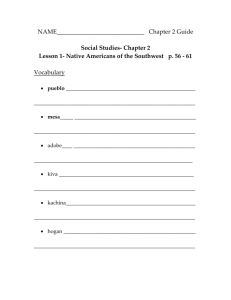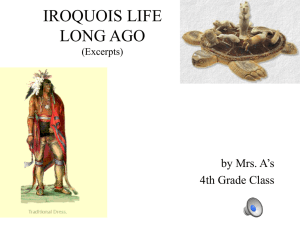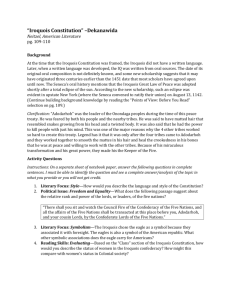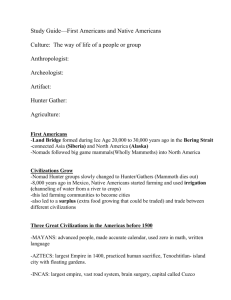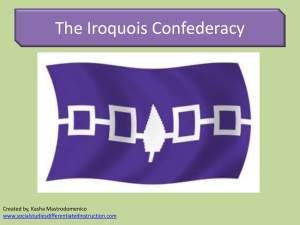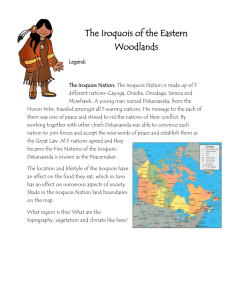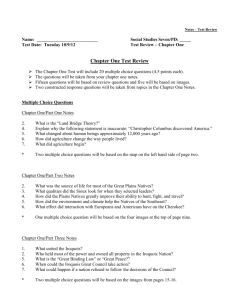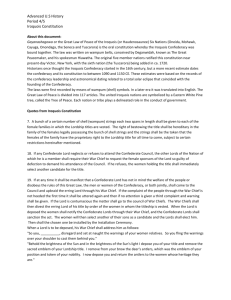What was the Iroquois Confederacy?
advertisement
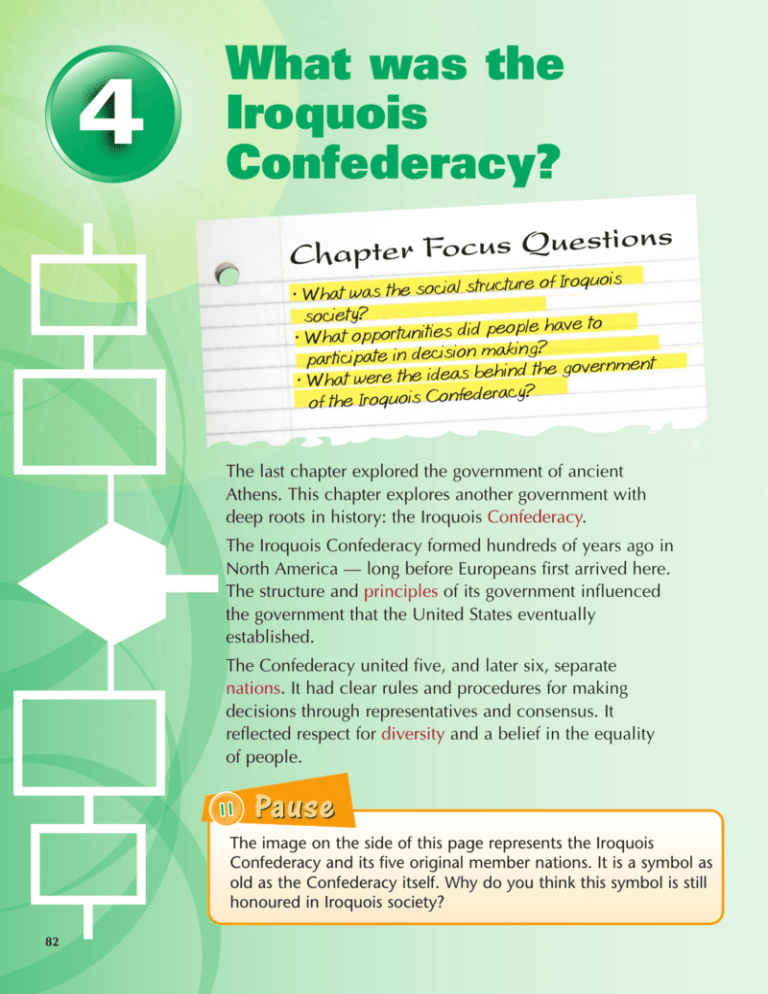
4 What was the Iroquois Confederacy? tions s e u Q s u c o F r te p a h C structure of Iroquois • What was the social society? d people have to • What opportunities di making? participate in decision hind the government be s ea id e th e er w t • Wha racy? of the Iroquois Confede The last chapter explored the government of ancient Athens. This chapter explores another government with deep roots in history: the Iroquois Confederacy. The Iroquois Confederacy formed hundreds of years ago in North America — long before Europeans first arrived here. The structure and principles of its government influenced the government that the United States eventually established. The Confederacy united five, and later six, separate nations. It had clear rules and procedures for making decisions through representatives and consensus. It reflected respect for diversity and a belief in the equality of people. Pause The image on the side of this page represents the Iroquois Confederacy and its five original member nations. It is a symbol as old as the Confederacy itself. Why do you think this symbol is still honoured in Iroquois society? 82 What are we learning in this chapter? This chapter explores the social structure of Iroquois society, which showed particular respect for women and for people of other cultures. It also explores the structure and processes of Iroquois government. Think back to Chapter 3, where you saw how the social structure of ancient Athens determined the way people participated in its government. In this chapter, you will learn about the roles and responsibilities of people in the Iroquois Confederacy. Why are we learning this? When you look around your community, what traces of the past can you see? For example, what is the oldest building in your community? What road first connected your community to other parts of your region? Just like buildings and roads, ideas have roots in the past. The ideas that shape Canada’s government today reflect ideas from other, older societies, such as the Iroquois Confederacy. By exploring the Confederacy, we are exploring ideas that affect us today — ideas such as equality, consensus and respect for diversity. We can learn more about them and discover how they influenced democracy. sus r e v s oi saunee u q o r I eno Haud There are two names for the Iroquois people today: Iroquois (ear-o-kwa) and Haudenosaunee (how-den-o-show-nee). Iroquois is a name that dates from the fur trade during the 1600s. The French learned this name from the Ouendat (wen-dat), an enemy nation of the Iroquois. Haudenosaunee is what the people call themselves in their own language. It means “people of the longhouse” and comes from the name for the people’s traditional dwelling. You need to know both names when you do research online or in the library. How do the names Iroquois and Haudenosaunee reflect the different perspectives of peoples? How do they reflect the history of North America? Chapter 4 83 Chapter 4 Inquiry Task Creating a multi-media presentation about the Iroquois Confederacy Introduction The Past to Present Exhibition is on the move! Directors of the exhibition have just unveiled their plans for a new multi-media presentation which will travel to Grade 6 classrooms. The purpose of the presentation is to share information about the society and government of the Iroquois Confederacy. The Task The Past to Present Exhibition has asked you to research and create a presentation entitled: “Democracy in Action: the Iroquois Confederacy.” To provide background information for Grade 6 students, you will need to explain historical context. Historical context means when and where something existed or happened. Provide information on the following points: • The structure of the Iroquois Confederacy • The role of women in the Iroquois Confederacy • The use of consensus in the Iroquois Confederacy • The importance of wampum belts to Iroquois identity Your presentation must conclude by giving evidence to answer the following question: • How did the Iroquois Confederacy establish the democratic ideas of fairness and equity? Since this presentation will be for Grade 6 students, you must think of an innovative and intriguing way of sharing this information. Remember to create a reference list so that people who attend the exhibition will know where you found your information and where they can find more information themselves. 84 Books Author (publication date). Title. Publication Location: Publisher. Example: • include references in an organized manner as part of research LS CEN 6 E Encyclopedias Title. (publication date). Publication Location: Publisher Plan a system for recording your references as you go. You could use a database or a chart. What system will work best for you? TR Cairo, Mary & Soncin, L (2003). Faces of Government. Edmonton: Duval House Publishing Inc. SKILLaSt Work S KIL Things to think about before starting the task As you work through the chapter, you will be gathering information that will help you with the task. When you are researching you should cite, or record your references. This means acknowledging the contribution of other people’s ideas. Use the following guidelines to reference your resources. Research Example: Encyclopedia Britannica. (2002). Chicago: Encyclopedia Britannica. On-Line Resources Great Lakes Information Network. (2007) Native Peoples of the Region: Settlements and Warfare: Flag of the Five Nations. Retrieved September 20, 2007 from the Great Lakes information network website. Chapter 4 85 SKILLaSt Work Before you begin this section, list some questions you have about Iroquois society and government. Consider whether the information in this section answers your questions. Jot down new questions you have, based on what you learn from this section. • formulate new questions as research progresses LS CEN E 6 TR S KIL • determine the reliability of information filtering for point of view and bias Research Getting Started How did the Iroquois Confederacy begin? What’s important? Understand that the Iroquois Confederacy is made up of separate nations, bound by the Great Law of Peace, and that it is many centuries old. It still exists today. Founding the Iroquois Confederacy Five different nations founded the Iroquois Confederacy: the Seneca (Sen-e-kuh), Cayuga (Ky-you-guh), Onondaga (On-on-da-guh), Oneida (O-nee-duh), Mohawk (Mo-hawk). Each nation kept its own territory, language and culture. Before the founding of the Confederacy, the nations fought wars against each other. The history of the Iroquois records that a leader came to the nations with a message of peace and unity. This leader was named Dekanawidah (da-ga-nawee-duh), the Peacemaker. With the help of Hiawatha, he persuaded each nation to accept the Great Law of Peace. The Great Law of Peace established a government — the Iroquois Confederacy — that allowed the nations to work together and respect each other. Pause The Great Law of Peace established an alliance among the member nations of the Iroquois Confederacy. An alliance is an agreement among a group of nations to support each other. The alliance that established the Iroquois Confederacy ended war among its member nations. What other advantages might an alliance have? 86 Where was the Iroquois Confederacy? The Lands of the Iroquois Confederacy before 1500 N Iroquois Confederacy AREA OF MAP E W S La wre nc e R. St . Atlantic Ocean The white lines on this map show borders that exist today between Canada and the United States, and between Canadian provinces. We have included them to help you interpret the location of the map. Mo O h On neida awk o n Sen Cayug daga a eca 0 250 km This map shows the location of the original five nations of the Iroquois Confederacy. Within the Confederacy, each nation had a role. For example, the Mohawk were the Keepers of the Eastern Door. They defended the Confederacy from the east. Based on the map, who were the Keepers of the Western Door? The nations on guard to the east and west were also called the “older brothers” of the Confederacy. One nation of the Confederacy was charged with keeping the centre of the Confederacy firm — keeping its principles always alive. They were called the Keepers of the Council Fire. Check the map: which nation was this? The nations between the guards and the centre were called the “younger brothers” of the Confederacy. Which nations were these? Pause The map of Iroquois lands on this page dates from before contact with Europeans. Compare the map with a current map of the same region. What changes do you see? What reasons can you give for the changes? Chapter 4 87 1702 Tuscarora join Iroquois Confederacy. 1776 United States founded. 1867 Canada founded: Confederation. ar ou nd 11 42 cy ra ed Iroq Con uois fou fede nd 1490s Europeans begin exploring North America. When was the Iroquois Confederacy? 500 0 Before the Common Era (BCE) SKILLaSt Work How does the timeline establish that the Confederacy could have influenced the founding of the United States and Canada, but not the other way around? LS CEN E 2 TR S KIL • use examples of events in the past to describe cause and effect and change over time Historical Thinking 88 500 1000 1500 2000 2500 Common Era (CE) The Iroquois Confederacy probably dates from around 1100, and continues to exist today. How many years has the Confederacy existed compared to the United States and to Canada? How can you use the timeline to establish this? The timeline shows that the Confederacy existed before Europeans began to explore North America. What do you already know about First Nations societies before contact with Europeans? A sixth nation, the Tuscarora (Tuh-skuh-roar-uh) left their southern homelands, in what later became North Carolina, due to European settlement. They joined the Iroquois Confederacy in 1702. The Confederacy then became known as the League of Six Nations. What happened when First Nations and Europeans began to encounter each other? Use your knowledge of history to help you understand the time when the Iroquois Confederacy began. I remember how the French and British competed for trading partners during the fur trade. What alliances and conflicts happened because of the fur trade? I wonder how this might have affected the Iroquois Confederacy? Investigating Time The timeline on page 88 dates the founding of the Iroquois Confederacy at around 1100. This reflects one theory of how old the Confederacy is. Oral history records that the Seneca were the last of the original five nations to join the Confederacy, and that this happened just after a total eclipse of the sun. Using astronomical data, researchers examined when solar eclipses occurred in the past. They consulted the oral record for a list of the Confederacy’s leaders, and estimated the span of time the list represented. Then they matched data about angles of the earth and sun with descriptions from the oral record about the historic eclipse. When they put all the pieces of evidence together, they suggested that the first five nations of the Confederacy completed their alliance shortly after a solar eclipse on August 31, 1142. Pause Oral history provides a record of the past. So does data from astronomy. What are some other ways to record history? In what ways are they the same? In what ways are they different? t is tory? a h W l his ora Different peoples have different ways of recording their past. The Haudenosaunee traditionally recounted their past in spoken, or oral, records. They had memory keepers who carefully learned and maintained these records from generation to generation. This photo shows a solar eclipse. What do you know about solar eclipses? Why can researchers pinpoint when they will happen in the future and when they have happened in the past? Chapter 4 89 How did the Iroquois live? What’s important? Understand the role of clans in the Iroquois Confederacy. Clans The Peacemaker established clans within the nations of the Iroquois Confederacy. The clan system united the nations and ensured peace among them. They are still an important part of the identity of Iroquois people today. Clans were named for one of nine air, water or land animals. With one exception, each clan formed part of at least two nations, and three clans formed part of every nation. The Peacemaker set up Iroquois society as matrilineal. This meant clan members traced their family history and ancestors through their mothers. Each clan was made up of a group of families that had a common female ancestor. When people married, the husband moved into his wife’s longhouse. When a child was born, he or she became part of the mother’s clan. Members of the same clan were considered family members. So, they always extended hospitality to each other, even if they came from different nations. Also, people of the same clan did not marry each other. Within each nation, members of the same clan lived together in a longhouse. You can read more about longhouses on page 92. Legend Nation Clan About the clan graphic The graphic on the next page comes from information posted by the Iroquois Museum in Howes Cave, New York. Use this legend to help you interpret it. How does this graphic help you understand the way clans wove the nations of the Iroquois Confederacy together? 90 Seneca Cayuga Onondaga Oneida Mohawk Older Brothers Younger Brothers Keepers of the Council Fire Younger Brothers Older Brothers Keepers of the Western Door Keepers of the Eastern Door wolf bear turtle snipe deer beaver heron hawk eel Chapter 4 91 What’s important? Understand the role of the longhouse in the Iroquois Confederacy. The Longhouse This photograph shows the interior of a longhouse at the Ganondagon historic site in New York. The site is a reconstruction of a Seneca settlement. In the longhouse, people lived their daily lives and met in groups to talk. What do you think children did when important discussions took place? What might they have learned from these discussions? 92 Within each member nation, the Iroquois lived in settlements made up of several longhouses. Longhouses were large, open dwellings where many families of the same clan lived together: grandparents, parents, aunts, uncles, sons, daughters and cousins. The longhouse was an important place in the government of the Iroquois. It was where men and women met in separate groups to discuss issues and events, and to advise their leaders. People were expected to attend these discussions, because the consensus — or agreement — of the group was crucial. By discussing issues, people came to understand how different choices would affect the group, and came to one mind about the best way forward. You can read more about what consensus means on page 111. Dutch geographer Herman Moll drew this scene of an Iroquois settlement in 1720. If 30 to 40 people lived in each longhouse, about how many people lived in this settlement? Moll, Herman (1736). A New Map of the North Parts of North America Claimed by France. London, England: T. Bowles. SKILLS at Work LS CEN E 6 TR Think about the European point of view of the artist and how this might have influenced what he included in this scene. To what extent does this illustration represent a reliable source of information about the Iroquois? S KIL Study the illustration carefully. What seems out of place? Research • determine the reliability of information filtering for point of view and bias Longhouses were made with a wooden-pole framework covered in bark. If a clan grew, how do you think the longhouse grew? What conclusions can you draw from this picture? Chapter 4 93 What was the social structure of Iroquois society? What’s important? Discover the roles of women and men in Iroquois society. In the story, Kanatiiosh and her brother stumble into a special meeting that was not part of daily life — a meeting of the Grand Council. The Grand Council always met in the Onondaga territory in a special longhouse. You can read more about the Grand Council on page 101. this t u Abory Sto This representation of historical events was written with the advice and assistance of educator Brenda Davis, Cayuga First Nation, Six Nations of the Grand River Territory, Ontario. quois Grand o Ir e th r fo n io is ec AD Council Part 1: An Escape “Come back here!” other in horror as her little br ed ch at w h) os e-te -a Kanatiiosh (kan house, an way of the council long or do e th to in t gh ai str bolted lage. the north side of her vil g on al t sa at th re tu imposing struc upted the brother before he disr r he e ev tri re to ly on the Thinking m. The dim interior of hi r te af ed w llo fo h os meeting, Kanatii nificent d her, but as the mag de in bl y ril ta en om m e longhous her. rgot all about her brot fo e sh , ed liz ia er at m r scene before he Who’s Who in the Iroquois Confederacy: Children Children were often around and listening when adults held discussions. Discussions were part of daily life in a longhouse. Children grew up hearing about issues and learning how decisions were made. Both women and men had important positions in the Iroquois Confederacy, so girls and boys knew they too would have important roles when they grew up. This berry basket was made by Susan Bearskin of the Oneida Nation. Day-to-day routines — such as making baskets, preserving food, cooking, eating and sleeping — took place in the longhouse. Discussions of events and issues also took place there. Daily life in the longhouse played an important role in the way the Iroquois governed themselves. 94 She remembered her grandmothe r — who was a Clan Mother — tell ing her the reason for this important meeting. The Hoyaneh (hoe-ya-n eh) were deciding whether to enter into a treaty with the British who had bu ilt a fort some distance away. Now she could actually see the Ho yaneh her grandmother spoke of, sitting right before her. She could see all the distinctive headdresses that identified their nations. These we re the men chosen by the Clan Mo thers to represent each clan in the five member nations of the Iroquois Confederacy. And right beside the m were the wise Clan Mothers themselves, sitting with straight spines, observing their Hoyaneh and listening intently to make sure the y represented the needs and intere sts of the people in everything they sai d. Kanatiiosh listened to the words of a tall man who addressed the Hoyaneh. From the look of his headdress, she could tell he was Onondaga, the nation responsible for opening the meetings and lighting the sacred fire that burned to purify the thoughts of everyone present. “I ask you to remember our contin uing conflict with the French,” the man said, his voice ringing out over the crowd. “Remember the sorrow on the faces of our people when French guns killed three of our kinsmen and twelve others were taken captive . We need to think carefully about how to defend ourselves.” Kanatiiosh heard murmurs of ack nowledgment ripple through the crowd. She, too, nodded her head in agr eement, crouching there in her dar k corner, remembering the tears her mother had shed when the new s came that her uncle was dead. Suddenly, Kanatiiosh felt a small hand slip into hers. “There you are !” she exclaimed to her brother, a little too loudly, for she noticed heads turning her way. “It’s time to leave,” she whispered in his ear, and slipped out. In the story, the Iroquois Confederacy is considering a treaty with the British. The story takes place during the fur trade in the 1600s, when the Iroquois came into conflict with the French. The French had become allies with enemies of the Iroquois, including the Ouendat. This illustration shows the Ouendat and the French attacking an Onondaga village in 1615 and was drawn from the French point of view. How accurate do you think the drawing is? Why? Chapter 4 95 Women in the Iroquois Confederacy Clan Mothers • chose and advised the Hoyaneh • had a strong indirect influence on decisions Women • participated in Women’s Councils which advised the Clan Mothers • used consensus Who’s Who in the Iroquois Confederacy: Women Women had two ways to make their voices heard: as Clan Mothers and through Women’s Councils. Clan Mothers continue to play an important role in Iroquois society today. This photo shows Audrey Shenandoah, a Clan Mother of the Eel Clan of the Onondaga Nation. She participated in a Summit of the Elders at the United Nations in 1995, where she provided an Iroquois perspective on environmental issues. Clan Mothers were usually the oldest and most respected women in their clans. The title was hereditary and passed on to the woman relative that was thought to be best suited for the position. Clan Mothers were responsible for their clan’s welfare and for maintaining harmony and balance within the clans and nations. They selected the Hoyaneh, the male leaders of the Iroquois Confederacy. The Great Law of Peace said the Hoyaneh had to put the needs of their people first. The Clan Mothers could replace Hoyaneh who failed to do this. Within each clan, Women’s Councils and Men’s Councils advised the Clan Mothers. The Clan Mothers in turn advised their Hoyaneh of the people’s position on issues. How did this process ensure that both men and women had a voice in their government? Women’s Councils developed positions on important issues. Women who were not Clan Mothers took part in councils. Through consensus, they advised the Clan Mothers. 96 Men in the Iroquois Confederacy Men Hoyaneh • made decisions for their nation • represented their nations and clans in the decision making of the Grand Council • used consensus • participated in Men’s Councils which advised the Clan Mothers • participated in decision making for their nation • used consensus • Hoyaneh were chosen from among the men Who’s Who in the Iroquois Confederacy: Men Men had two ways to make their voices heard: as Hoyaneh and through Men’s Councils. Hoyaneh were the male leaders of each nation of the Iroquois Confederacy. Hoyaneh means “Caretakers of the Peace.” Today we call them chiefs. The Hoyaneh were chosen and advised by their Clan Mothers. Each nation had several Hoyaneh. Most of the time, they met to make decisions for their nation — decisions about whether to expand or move a village, for example. They used consensus to arrive at the best way forward. The Hoyaneh also represented their nation at meetings of the Grand Council. You can read more about the Grand Council on page 101. Men’s Councils included all the men in a clan. They met and came to consensus on issues. They, like the women of clans, advised the Clan Mothers. Chapter 4 97 ture Leader Part 2: Preparing a Fu ily’s g platform in her fam in ep sle r he to on d be h clim That night, as Kanatiios other came to her. longhouse, her grandm ked. ” her grandmother as g? tin ee m e th of k in “What did you th t to say. d she didn’t know wha an t, ho go ce fa r he lt Kanatiiosh fe ere you doing there?” w t ha W e. us ho ng lo the council “I saw you slip inside sed. her grandmother pres h ng him out,” Kanatiios tti ge st ju as w I d an in “My little brother ran ink anyone saw me.” th ’t dn di “I . ed er sw an t you to r, I saw you. And I wan te gh au dd an gr y m t “Hardly anyone did. Bu you don’t think I see.” gs in th of t lo a e se I know “Like what?” ake the children how to m ow sh u yo n he w e ar u “Like how patient yo rries you pick in the be e th e ar sh to e ar u yo e a great baskets. And how quick e of things, you’ll mak sid od go e th on y sta summertime. If you y.” Clan Mother some da eepishly. y?” Kanatiiosh asked sh da to of e us ca be e m “Are you angry with e you should know mor k in th ly al tu ac “I d. ie r repl u can be.” “No,” her grandmothe great leader I think yo e th e m co be to re u’ about these things if yo At the Grand Council, the Hoyaneh wore distinct headdresses that identified them with their nation. In the Iroquois Confederacy, each nation was represented by its own Hoyaneh. How did this show respect for the diversity of the Confederacy’s member nations? Cayuga 98 Oneida Kanatiiosh lowered he r eyes in respect. “Oh, Grandmother, to day I actually saw the sacred fire you’ve alw told me about,” Kana ays tiiosh said, her words co m in g in a rush. “And I saw how closely the Ho yaneh listened to the O no ndaga leader who spoke. Everything seem ed so important. And serious.” “It is,” agreed Skawen nati. “Treaty-making is not taken lightly amon the Iroquois.” g “Are they any closer to making a decision?” “Yes. Just today the G rand Council agreed to negotiate a treaty. Now the Hoyaneh must wor k out the terms and ev eryone must agree to them.” “Grandmother, can yo u tell me everything th at happens when such an important decision is being made?” “I can, Kanatiiosh, bu t not tonight. You have to be at the cooking fires early to help feed the visiting Hoyaneh, so I’ll tell you all abou tomorrow after the ev t it ening meal, all right?” “All right,” Kanatiiosh echoed, barely stifling a yawn as her grandmother tucked he r in. Mohawk Seneca Onondaga Chapter 4 99 What opportunities did people have to participate in decision making? What’s important? Understand the rights and responsibilities of men and women in the government of the Iroquois Confederacy. e Iroquois awennati described th Sk g in en ev xt ne e th True to her word, s. ue decision-making proces ca, must discuss the iss ne Se e th d an k aw oh rs, the M nsensus “First the elder brothe ion, they pass their co cis de a h ac re ey th n he e among themselves. W neida and Cayuga. Th O e th , rs he ot br r ge to the youn d across the sacred fire rs discuss the matter an he ot br r ge un yo e th hile unger elder brothers listen w e older brothers and yo th n he W s. su en ns co are arrive at their own s of the Council Fire — er ep ke e th — a ag nd no brothers agree, the O ement. asked to give their judg ly. natiiosh asked curious Ka ?” ee gr sa di h ne ya a Ho “What if the Onondag r and the process to the elde h ug ro th ck ba es go “Then their decision .” to reconsider the issue ve ha ld ou w ho w , rs younger brothe ” re a decision is made? fo be ue iss an on e re “So everyone has to ag ten ourselves. We must lis rn ve go to us ht ug ta emaker rtant.” “Yes. It is how the Peac the discussion is impo to gs in br h ne ya Ho ch to each other. What ea How did the Grand Council make decisions? First Step Second Step The Older Brothers The Younger Brothers Seneca & Mohawk Cayuga & Oneida reach consensus reach consensus until consensus is reached if Onandaga do not confirm the decision 100 The Grand Council The Grand Council met to discuss issues that affected the whole Iroquois Confederacy, such as peace treaties, trade agreements, and decisions to go to war. The Grand Council was made up of the Hoyaneh from each nation — 50 in all. Although they rarely spoke at Grand Council meetings, all Iroquois people — men and women — had ways to make their voices heard in the decision making of the Grand Council. Through the Women’s Councils and Men’s Councils of their clans, they advised the Clan Mothers of their positions on issues. The Clan Mothers, in turn, chose and advised the Hoyaneh. If a Hoyaneh didn’t carefully consider the advice of his Clan Mother, the Clan Mother warned him. After the third warning, she removed him and chose someone else. The order and procedure for a meeting of the Grand Council was given by the Peacemaker in the Great Law of Peace. The Tuscarora, who joined the Confederacy in 1702, are considered part of the younger brothers and speak through the Oneidas in council. To make a decision, the Grand Council discussed issues in a set order. Council decisions had to be unanimous, so the Grand Council always worked towards consensus. This is the way decisions about traditional and cultural matters are made by the Iroquois today. Pause Third Step The Keepers of the Council Fire The Grand Council used consensus to make decisions. Decisions depended on building an agreement that included all nations, and discussion continued until the Grand Council had reached agreement. • What advantages did this process have as a way to make decisions? • What disadvantages might it have? Onondaga give a judgement if all nations agree decision Chapter 4 101 The Iroquois Confederacy: Structure of Government Within each clan and nation, councils of men and women discussed issues and advised the Clan Mothers. The Clan Mothers chose the Hoyaneh to represent their people. This graphic shows the Mohawk Nation as an example of the process every nation used. f r e j Within each nation, the Hoyaneh formed a council for that nation. This council made decisions that helped its nation function well, such as sharing resources and locating settlements. Mohawk Council 3 Hoyaneh 3 Hoyaneh 3 Clan Mothers 3 Clan Mothers Women’s Council Men’s Council Women’s Council Men’s Council 3 Hoyaneh Wolf Clan Turtle Clan 3 Clan Mothers Women’s Council Men’s Council Bear Clan Mohawk Legend decisions made by consensus 102 choose and advise represent advise The Hoyaneh from each nation represented their people on the Grand Council. The number of Hoyaneh for each nation was established by the Peacemaker. The Grand Council met when a member nation called for a meeting. The role of the Hoyaneh at Grand Council meetings was to represent the people of their clan and nation. The Clan Mothers advised the Hoyaneh and attended Grand Council meetings to make sure their Hoyaneh fulfilled their role as representatives. Onondaga 14 Hoyaneh The nations had different numbers of Hoyaneh representing them on the Grand Council, but each nation was equal in the decision-making process. How did the use of consensus ensure this? Flip back to the graphic of the process on pages 100 and 101. Mohawk Cayuga 9 Hoyaneh 10 Hoyaneh f r e j Grand Council 50 Hoyaneh Seneca Oneida 8 Hoyaneh 9 Hoyaneh Think About the Task Part of your task in this chapter is to describe the role of consensus in the Iroquois Confederacy. Examine the diagrams on these two pages. How did the consensus of the Women’s Councils and Men’s Councils contribute to the consensus of the Grand Council? Try to summarize the connection between them. Chapter 4 103 What’s important? Understand the meaning and importance of wampum. aled Part 3: A Treaty Reve rls her worked beside other gi h os tii na Ka as r, te la Many days d, ttles of corn soup stoke ke e th h at ne be es fir age to keep the oak to the shade of a huge in r he d lle ca r he ot her grandm tree. show t something special to gh ou br ve ha I , er ht “Granddaug ner she held said, opening a contai r he ot dm an gr r he ” you, rms h decided upon the te ne ya Ho e th r fte “A . m under her ar of it.” ade as a lasting record m as w is th y, at tre e of th laid a r grandmother gently he as e rg la ew gr es ey Kanatiiosh’s ith two on the grass, woven w lt be m pu am w t en fic magni ainst a background of ag s ad be m pu am w le rows of purp white wampum beads. ked, sucking in her as h os tii na Ka ” n? ea m “What does it breath. e Guswentah (gus-wen th s “i , id sa r he ot dm “This,” her gran the m Treaty. It describes pu am W w Ro o Tw e ta) — th sh. nfederacy and the Briti Co s oi qu Iro e th n ee agreement betw d respect te peace, friendship an no de it on es ip str te The whi of ement. The two lines re ag e th of es rti pa o between the tw s of our rent customs and way ffe di e th fy ni sig s ad purple be rallel, never touching. pa e ar es lin le rp pu e two peoples. Th ill make ty says ‘neither of us w ea Tr m pu am W w Ro The Two her.’” the business of the ot ith w re rfe te in r no s w la h said e in peace,” Kanatiios liv l al n ca e w ay w ly “It’s the on by ld understand and live ou w sh iti Br e th ng pi thoughtfully, ho pum belt represented. the agreement the wam This is a photograph of the Two Row Wampum Treaty. On page 105, read about the Treaty. What is the meaning of the stripes? 104 The Guswentah, the Two Row Wampum Treaty When the Iroquois first encountered Europeans, they discovered people with very different ways and values from their own. The Iroquois proposed a peace treaty — the Two Row Wampum Treaty — based on three values: friendship, peace and mutual respect. Each of the white lines in the Two Row Wampum Treaty represents one of these values. The Two Row Wampum Treaty defines the relationship between the sovereign nations who agree to the treaty. The Iroquois concluded the Two Row Wampum Treaty with the British in 1674. They also made this treaty with other people of European descent, including the Dutch, French and the Americans. This is a modern replica of the Two Row Wampum Treaty. Why might the Iroquois today create replicas of this historic treaty? SKILLaSt Work –Adapted from Degiya’göh Resources. (2007) Guswenta (Kaswentha):Two Row Wampum. Retrieved October 18, 2007 from Degiya’göh Resources website. Where does the information on this computer screen come from? What makes this a good source of information? How does documenting your sources of information help support your conclusions? • include references in an organized manner as part of research LS CEN E 6 TR S KIL The following interpretation of the Two Row Wampum comes from an Iroquois website: The two rows symbolize two vessels, travelling down the same river together. One, a birch bark canoe, will be for the Iroquois People, their laws, their customs and their ways. The other, a ship, will be for the European people and their laws, their customs and their ways. We shall travel the river together, side by side. Neither of us will interfere with the affairs of the other. Neither of us will try to steer the other’s vessel. Research Chapter 4 105 Wampum Among the Iroquois, wampum beads made from shells are woven into patterned strings or belts that record important events, ideas, contracts, pledges or treaties among nations. When Europeans began to arrive in North America, the Iroquois negotiated and concluded agreements with the newcomers and presented them with records of the agreements in wampum. Wampum strings and belts were used at councils and in ceremonies of the Iroquois, and still are. The wampum belts in this photograph were held by the Museum of the American Indian in the United States for years. In 1989, the museum returned them to the Iroquois. Jacob E. Thomas of the Cayuga Nation, on the right, is reading the belts for the museum’s curator. The belts are historical records. Why are historical records important to the collective identity of a people – their sense of themselves as a group? Why might the Iroquois have wanted these wampum belts returned? 106 The Hiawatha Wampum Belt This wampum belt records the structure and principles of the Iroquois Confederacy. Each of the figures on the belt represents one of the original five nations of the Confederacy, in their geographic order. The Tuscarora are not represented by a symbol on the Hiawatha Wampum belt because they joined the Iroquois Confederacy many years after it was founded. SKILLaSt Work What information about the foundation, structure and processes of the Iroquois Confederacy do wampum belts provide? Why are primary sources such as wampum belts valuable? LS CEN E 3 TR S KIL • use primary sources to interpret historical events and issues Geographic Thinking Seneca Oneida Cayuga Mohawk Onondaga This figure represents the Tree of Peace and it stands at the centre of the Confederacy. You can read more about the Tree of Peace on page 108. The white line that joins the nations symbolizes the path of peace. It extends out from both sides of the belt. This invites other nations to follow the path of peace, accept the Great Law of Peace, and take shelter under the Tree of Peace. Chapter 4 107 What are the ideas behind the Iroquois Confederacy? The Tree of Peace The Iroquois Confederacy united five, and eventually six, separate nations in peace. The Peacemaker used the Tree of Peace, a white pine, to symbolize the peace established by the Confederacy. The branches represent the protection of the nations under the Great Law of Peace. The eagle has a place at the top of the tree. The eagle can see far and warn the people of the Confederacy of any danger. Pause The Tree of Peace is a symbol of the Iroquois Confederacy. Symbols represent ideas. What important ideas about the Iroquois Confederacy does the Tree of Peace communicate? The weapon buried beneath the tree shows that the Iroquois will not fight against each other. They have thrown the weapons of war into the depths of the earth. 108 The Great Law of Peace The Peacemaker established the structure and procedures of the Confederacy, which is the Great Law of Peace. Below, you can read an excerpt from the Great Law of Peace that talks about the responsibilities of the Hoyaneh. freedoms representation equity justice e advisors of th e b ll a sh s n atio all be of the five n their skin sh f o ss e n The Hoyaneh k ic regard time. The th they will dis t a th people for all y sa to them. – which is done against s g n ro w seven spans d eir n a goodwill. Th gainst them d a n a id e c sa a s e p rd o h w wit hey shall be filled eir people. T th f o re a Their hearts lf e w ce, and earn for the ndless patien e h it minds will y w s e ti and u ut their d dness. Anger in k h it w shall carry o t g u be handed o nd everythin l a il s, w d ss in e m n ir rm e fi th t find place in lm deliberation. fury shall no a c do will show d n a y sa y e th of e Great Law th f o 4 2 n o n ti s Reclamatio ersions of sec n v o n ti a o N d se ix a S B s: – te e following si erature. Peace from th s People’s Lit u o n e ig d In and Information Pause 1. What characteristics does the Great Law of Peace say that the Hoyaneh need? 2. Think about the structure of Iroquois government and the role that the Hoyaneh played in it. Why do you think the Great Law of Peace specified these characteristics for the Hoyaneh? The roots represent peace and strength. They spread out in the four directions: north, south, east and west. The roots lead anyone or any nation willing to follow the Great Law of Peace to the shelter under the tree. Chapter 4 109 What’s important? The Great Law of Peace defines the roles of men and women in the traditional government of the Iroquois Confederacy. How did these different roles support Iroquois society and government? lities i b i s n o p s and Re s t h g i R s i Iroquo ies Responsibilit d n a ts h ig R Women’s ers: w of Peace As Clan Moth a L t a re G e th and keeping • Knowing n re of their cla a lf e w e th g n Council and • Promoti ’s n e m o W e e advice of th • Seeking th uncil of their clan the Men’s Co h g the Hoyane in is v d a d n a • Choosing ouncils: In Women’s C nsus on issues se n o c a g in d il • Bu rs e Clan Mothe • Advising th ies Responsibilit d n a ts h ig R Men’s e As Hoyaneh: t Law of Peac a cil re G e th g in eep e Grand Coun k th d d n n a a g s in ie n w o o m • Kn eir role in cere th g n li il lf fu d an others • Knowing of the Clan M e ic v d a e th in the future to d g n a in n w te o is n L le p • eo best for their p s t’ a h w f o g in • Think s on issues su n se n o c a g • Buildin earted est and kindh n o h g in e B • and criticism st h it w to le b • Being a ncils: In Men’s Cou es nsensus on issu o c a g in d il u • B What qualities do effective lan Mothers C e th g in is v d • A leaders have today? Pause 110 Consensus What’s important? Societies have different ways of putting the democratic ideals of equity and fairness into action. What do the statements below show about fairness and equity in the Iroquois Confederacy ? What similarities and differences do you see between the Iroquois Confederacy and ancient Athens? True consensus is built through talking, listening and considering different ideas until a new understanding takes place, and the decision makers come to “one mind” about what to do. Everyone must have a voice. Everyone has their own stories, their own perspectives — gifts they bring to the process that create balance. No one is left out. — From an interview with Norma General, Elder of the Wolf Clan, Cayuga Nation, May 2007. Norma General lives in Ohsweken, Ontario. She is a member of the Cayuga Nation and an Elder, Wolf Clan. Her traditional name, Gaihohwakohn, means “holding the canoe.” She is a cultural educator across Canada and the United States, an instructor at McMaster University in Hamilton, Ontario, and an instructor at the First Nations Technical Institute in Tyandenaga, Ontario. Pause Consider Elder Norma General’s explanation of consensus. How might what she says apply to you? Think about the personal guideline for participating in groups that you created in Chapter 1. What could you add to your guideline, based on the ideas of consensus? What advantages does consensus have as a way to make choices in groups? Chapter 4 111 The Society and Government of the Iroquois Confederacy What is the structure of the society? What rights and responsibilities do members of the society have? This photo shows Haudenosaunee people in a circle dance. In what ways does a circle represent something important about traditional Iroquois society and government? 112 • There were originally five, and later six, separate Iroquois Nations. Each has its own language and its own council. • Each nation has specific clans which are extended families of the same clan of other nations. • Families are connected through the women’s lines. • Extended families used to live in longhouses. • All members of society are expected to follow the Great Law of Peace. • Clan mothers listen to their clan members, give advice and choose their Hoyaneh. • The Hoyaneh listen to their Clan Mothers and are responsible for representing their own clan and nation. They are also responsible for helping make Grand Council decisions. • Each member nation of the Confederacy is equally important on the council. What is the procedure for making government decisions? How do members of society influence government decisions? • The Grand Council is composed of 50 Hoyaneh representing their clans and nations. • The Grand Council makes decisions affecting the entire Confederacy. • The member nations hold discussions in a set order. • The Hoyaneh from each nation must reach consensus. • Decisions are agreed on only after consensus from the entire Council. • Decisions were traditionally recorded with wampum belts. • Clan Mothers choose the Hoyaneh and ensure they adequately represent their people. • Both men’s and and women’s voices are heard through the Men’s Councils and Women’s Councils that advise the Clan Mothers. The Clan Mothers advise the Hoyaneh. Pause The Iroquois planted corn, beans and squash together, calling these “the Three Sisters.” The cornstalks provided support for the growing beans, which provided nitrogen to fertilize the soil. Low lying squash leaves sheltered the plants roots and retained soil moisture. How can the Three Sisters provide a model for the way Iroquois society functioned? Chapter 4 113 This sign marks land along the Grand River in Ontario, where some members of the Iroquois Confederacy live today. The Iroquois moved to the Grand River because of the American War of Independence, from 1776 to 1783, in which the United States fought Britain. After the war, members of the Iroquois who had supported Britain during the war left the United States. SKILLS at Work On a map of Canada, locate Brantford, Ontario. Brantford is named after Joseph Brant, the Iroquois leader who established the Six Nations of the Grand River Territory in Canada. The territory lies southwest of Brantford along the Grand River. 114 CEN 3 E • use cardinal and intermediate directions to locate places on maps and globes LS TR • construct and interpret maps to broaden understanding of topics being studied S KIL How does this location compare with the original location of the Iroquois Confederacy, where many Iroquois continue to live today? Consult the map on page 87 to formulate your conclusion. Geographic Thinking Review! Review! 1. What was the traditional social structure of the Iroquois? Construct a mind map or diagram to show the structure of the Iroquois society. freedoms representation equity justice 2. What opportunities did the people have to participate in decision making? What was the role that different members of Iroquois people had when decisions needed to be made? Use your knowledge to complete the comparison chart. An example is given. A young Iroquois woman She could discuss her ideas with the women’s council or with the Clan Mother. The Clan Mother’s advice and wisdom was sought by the Hoyandeh. A Clan Mother One of the Hoyaneh A young Iroquois man 3. How did the decision making process within the Iroquois Confederacy show equity and fairness? Answer this question orally, backing up your ideas with evidence. Hint: How would Kanatiiosh, the Clan Mother’s granddaughter, have answered this question? Chapter 4 115
